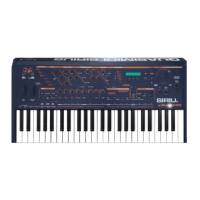In some cases it might be necessary to change this allocation to adapt to your MIDI-setup. This you
can do in the System-menu. On page 3 of this menu you find the Parameter "M.Channel". It allows
you to set the Master-channel of the Sirius. In the above described factory setting it has the value 1. If
you set the value to 5 for instance the allocation of the MIDI-channels will change as follows:
The order of the Parts in relation to one another is fixed, due to the system configuration,
and cannot be changed.
Another very important function can be found on page 4 of the system-menu: the Parameter Local
On/Off. This parameter is often the solution for many problems that might occur when using the
Sirius with an external sequencer.
The factory settings of this parameter are set to ON - the only sensible setting all the time the Sirius is
being used as a stand-alone unit.
If the Parameter is switched to OFF the following happens: The keyboard is separated from the
sound sources within the Sirius. If you now press a key the MIDI-information "note-on" will not reach
the Synthesizer of the Sirius anymore. Instead this signal will immediately be sent to the MIDI-Out
socket of the Sirius. The Synthesizer is now able to receive MIDI-data only which gets to the unit via
the MIDI-In socket. The next thing would of course be to connect the MIDI-Out again with the
MIDI-In. This task is in most studios dedicated to the sequencer software. The advantages of such a
system are clear: If for instance the Kick-Part (MIDI-channel 1) on the Sirius has been selected but in
the external sequencer the Synth1-Part (MIDI-channel 5) has been selected, only the Synth 1-Part
will play out when you play the keyboard. The setting Local-ON would in this instance also have the
Kick-Part playing.
What is true for the Keyboard of the Sirius is also true for the Internal- Sequencer. The Position Local
OFF will separate the Internal Sequencer form the internal sounds. This is always an advantage when
a pattern or a song of the Sirius is to be recorded into an external sequencer. How you put this into
practice will be explained a little later with some examples. (see section " Recording Sirius-Patterns
and Songs into an External Sequencer")
The diagram "The Local-Off Function of the Sirius" on the following page will show the above func-
tion in detail.
MIDI-Channel 5: Kick
MIDI- 6: Snare
MIDI- 7: Hihat
MIDI- 8: Percussion
MIDI- 9: Synth 1
MIDI- 10: Synth 2
MIDI- 11: Synth 3
Edit System/Midi
<3> M.Channel: 5
Edit System/Midi
<4> Local: ON
Edit System/Midi
<4> Local: OFF
Channel
Channel
Channel
Channel
Channel
Channel
Caution:
Menu-page 4 (Local-Off):
The System-Menu
95
!
See page 116

